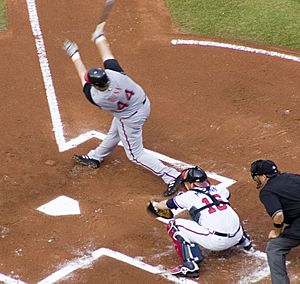Strikeout facts for kids
In baseball and softball, a strikeout happens when a batter gets three strikes during their turn at bat. Usually, this means the batter is out. A strikeout is a stat recorded for both pitchers and batters. It's shown as K. If a batter doesn't swing and the umpire calls the third strike, it's called a "strikeout looking" and is often shown as ꓘ.
Even though a strikeout makes it seem like the pitcher was much better than the batter, batters who swing hard to hit home runs often strike out more. Some of the best home run hitters ever, like Alex Rodriguez, Reggie Jackson, and Jim Thome, were also known for striking out a lot.
Contents
What is a Strike?
An umpire calls a pitch a ball if the batter doesn't swing and the ball doesn't go through the strike zone. A pitch is called a strike if the batter swings and misses, or if the ball goes through the strike zone and the batter doesn't swing.
Each ball and strike changes the count (like 1 ball, 2 strikes). If a batter hits a foul ball (a ball hit outside the playing area) when they already have two strikes, it doesn't count as a third strike. So, a third strike can only happen if the batter swings and misses, or if the umpire calls the pitch a strike without the batter swinging. If the batter hits the ball into play, it's not a strike or a foul. A batter can also strike out by trying to bunt the ball foul, even if it's not caught.
When is a Batter Out on a Strikeout?
A pitcher gets credit for a strikeout (and the batter gets charged with one) on any third strike. But the batter is only out if one of these things happens:
- The catcher catches the third strike in the air (this includes foul tips, which are slight touches of the ball).
- There's a runner on first base and there are zero or one outs.
- The batter tries to bunt the third strike foul, and no fielder catches it.
The Uncaught Third Strike
Sometimes, a batter can strike out but still get on base! This happens if the catcher doesn't catch the third strike cleanly. If the catcher drops the ball, they have to tag the batter or throw the ball to first base to get the batter out. If they don't, the batter can run to first base safely.
When this happens, it's called an uncaught third strike. A strikeout is still recorded for both the pitcher and the batter, but no "out" is added to the game's score. Because of this, a pitcher might sometimes get more than three strikeouts in one half of an inning!
How Strikeouts are Recorded
In baseball scorekeeping, a swinging strikeout is usually written as K. A strikeout where the batter doesn't swing (a "strikeout looking") is often shown with a backwards K (ꓘ). Sometimes, you might see K-L or Kc (the 'c' means 'called' strike). Even though they are written differently, both types of strikeouts count the same in the game. The different symbols just help keep track of how the strikeout happened.
Even though "K" is common among fans, the official abbreviation used by Major League Baseball is "SO".
Fans often use "K" signs at games. They hang up small "K" signs on railings, adding one for every strikeout the home team's pitcher gets. This tradition started with New York Mets fans who cheered for their pitcher, Dwight Gooden, nicknamed "Dr. K." If the batter strikes out looking, the "K" sign might even be placed backwards (ꓘ), just like on a scorecard.
Why "K" for Strikeout?
The letter "K" for a strikeout was first used by Henry Chadwick. He was a newspaper journalist who created the box score and the baseball scorecard. These ways of keeping score are still used today! Chadwick chose "K" because it was the last letter in the word "struck." He couldn't use "S" because "S" was already used for "sacrifice." Chadwick also came up with other ways to keep score, like using numbers for player positions.
Some people used to think "K" came from the last name of a 19th-century pitcher named Matt Kilroy. He was famous for strikeouts, setting a record of 513 strikeouts in 1886. But Chadwick used "K" before Kilroy became famous, so that idea isn't correct.
Strikeout Records
For 55 years, Walter Johnson held the record for the most career strikeouts with 3,508. In 1982, Nolan Ryan broke that record. Then, Steve Carlton passed Ryan, but Ryan took the career strikeout record back for good, ending with an amazing 5,714 strikeouts!
The modern record (since 1901) for most strikeouts in one season is 383, held by Nolan Ryan. This is just one more than Sandy Koufax's 382 strikeouts.
Images for kids
-
Hall of Famer Sandy Koufax
See also
 In Spanish: Strikeout para niños
In Spanish: Strikeout para niños



